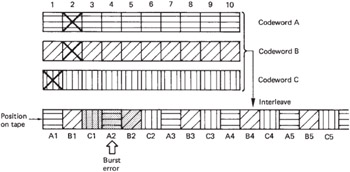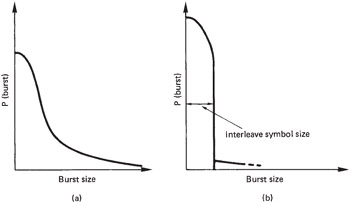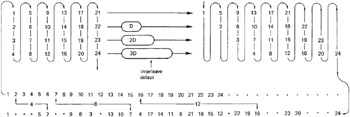3.19 Interleaving
| | ||
| | ||
| | ||
3.19 Interleaving
The concept of bit interleaving was introduced in connection with a single-bit correcting code to allow it to correct small bursts. With burst-correcting codes such as Reed-Solomon, bit interleave is unnecessary. In some channels, the burst size may be many bytes rather than bits, and to rely on a code alone to correct such errors would require a lot of redundancy. The solution in this case is to employ symbol interleaving, as shown in Figure 3.32. Several codewords are encoded from input data, but these are not recorded in the order they were input, but are physically reordered in the channel, so that a real burst error is split into smaller bursts in several codewords. The size of the burst seen by each codeword is now determined primarily by the parameters of the interleave, and Figure 3.33 shows that the probability of occurrence of bursts with respect to the burst length in a given codeword is modified. The number of bits in the interleave word can be made equal to the burst-correcting ability of the code in the knowledge that it will be exceeded only very infrequently.

Figure 3.32: The interleave controls the size of burst errors in individual codewords.

Figure 3.33: (a) The distribution of burst sizes might look like this. (b) Following interleave, the burst size within a codeword is controlled to that of the interleave symbol size, except for gross errors which have low probability.
There are a number of different ways in which interleaving can be performed. Figure 3.34 shows that, in block interleaving, words are reordered within blocks that are correctly ordered. The block interleave is achieved by writing samples into a memory in sequential address locations from a counter, and reading the memory with non-sequential addresses from a sequencer. The effect is to convert a one-dimensional sequence of samples into a two-dimensional structure having rows and columns .

Figure 3.34: In block interleaving, data are scrambled within blocks that are themselves in the correct order.
The alternative to block interleaving is convolutional interleaving where the interleave process is endless. In Figure 3.35 symbols are assembled into short blocks and then delayed by an amount proportional to the position in the block. It will be seen from the figure that the delays have the effect of shearing the symbols so that columns on the left side of the diagram become diagonals on the right. When the columns on the right are read, the convolutional interleave will be obtained. Convolutional interleave works well in transmission applications such as DVB where the signal is continuous. Convolutional interleave has the advantage of requiring less memory to implement than a block code. This is because a block code requires the entire block to be written into the memory before it can be read, whereas a convolutional code requires only enough memory to cause the required delays.

Figure 3.35: In convolutional interleaving, samples are formed into a rectangular array, which is sheared by subjecting each row to a different delay. The sheared array is read in vertical columns to provide the interleaved output. In this example, samples will be found at 4, 8 and 12 places away from their original order.
| | ||
| | ||
| | ||
EAN: 2147483647
Pages: 120